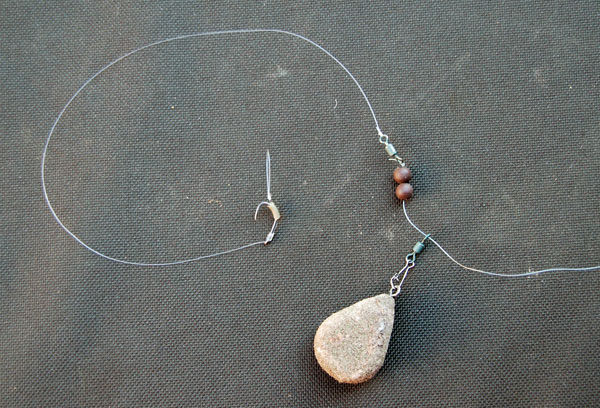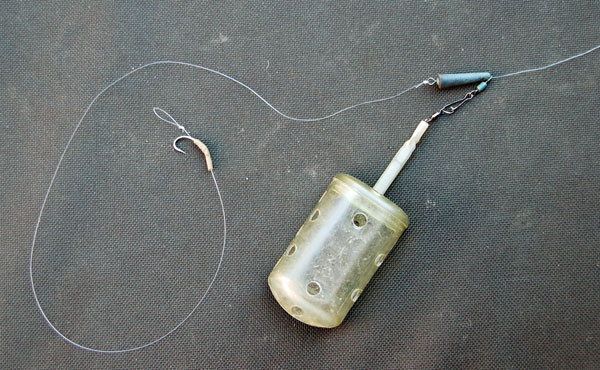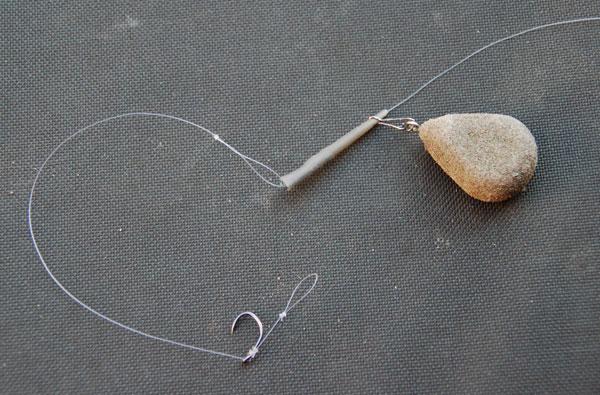 One of Dave Burr's barbel rigs
One of Dave Burr's barbel rigs Following a forum thread about running barbel rigs Dave Burr reveals what he uses.
As there are always newcomers to barbel fishing and of course, FishingMagic, the question of which rig to use is frequently asked. In an attempt to help the new guys and to get them on their way to fishing with an effective and above all safe rig, I have tied a few up and will describe them here. All of the examples here have been tied with fluorocarbon but you can use any hooklink material such as braid, mono, coated braid, etc.
Before you put any rig in the water ask yourself the questions, 'Does it do what I want it to do?' And 'Can a fish free itself from it in the event of a break-off?'
Rig one is a straightforward rig that has accounted for thousands of barbel and which is probably all you will need for your first season or two.

Rig 1
Your first requirement is a good hook. There are plenty of excellent patterns on the market, I suggest you pick one or two from recommendation and see how you get on with them, you will soon find a pattern that catches for you and thereby will give you the all important confidence.
On this rig the hooklength ends with a swivel, above that on the main line, is a couple of soft rubber beads to protect the knot from the link swivel. They will also give a degree of 'stand-off' which will help to reduce the number of tangles; trust me, if your line twists around your swivel and a barbel runs, it will crack the line off in a nano-second.
This rig can be used with any size of hooklength from three inches to three foot.
Easy isn't it?

Rig 2
On the second rig the rubber beads have been replaced with a tail rubber which has the same effect but which covers the swivel and gives a more rigid stand-off, this is far more important when feeder fishing. The choice between either beads or tail rubber is entirely personal one, try them both then see which one suits your fishing the best.

Rig 3
The third example is the rig that I have been using for the last season or so, it is simple but highly effective. Instead of a swivel at the end of the hooklength I use a quick-link , the hooklink is attached to that by simple figure of eight loop and enables a rapid change of hooklink should it be needed. The main line is tied to the link and a Korda anti-tangle sleeve is pulled over the top of it. To attach the lead I simply take the link from a link swivel (these can be bought separately in packets of ten) and fold it over the sleeve. The critical part of this is to make sure that the link only just grips the sleeve and will pull off easily. If you ram it on farther up the sleeve it will grip the main line and should you break off above the rig you will have created a tether rig that a barbel will not be able to rid itself from and it will then surely die.
So, I will repeat, make sure that the sleeve can still run on the line with the link attached, it may take slight effort to move it but at least it will slide. You now have a rig that is quick and simple to tie, offers terrific stand-off qualities and is semi-fixed and highly effective at hooking fish.
You will note that none of my rigs incorporate a stop bead or float rubber above the lead, I do not think that it is necessary as there is sufficient pressure from the fish pulling the line and lead to set a hook. Any rig with a back stop runs the risk of it becoming a tether rig whereas my rig, even if the lead clip is set too hard, still give a fish a chance to rid itself of it.
There are other rigs, some are more complicated and all will take fish but if you tie up any of those demonstrated here you will take all the barbel you want. Just remember, use sharp hooks and tie good knots, if you have any doubts about any of your knots don't hesitate, cut them off and tie them again, that few seconds could save you from months of regret when you lose a biggie.
And last of all I will remind you of the comment at the beginning. Before you put any rig in the water ask yourself the questions, 'Does it do what I want it to do?' And 'Can a fish free itself from it in the event of a break off?'